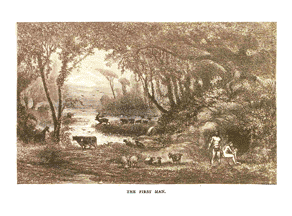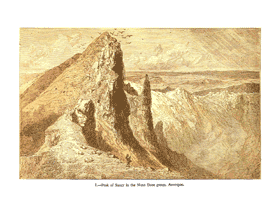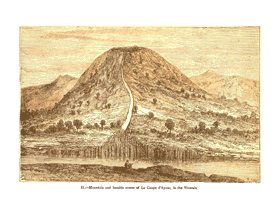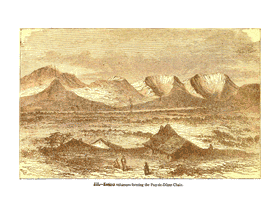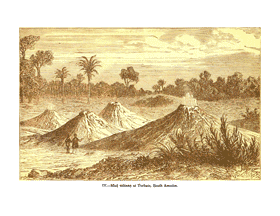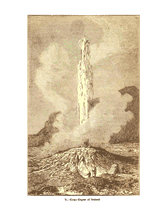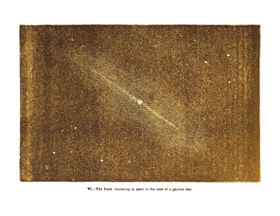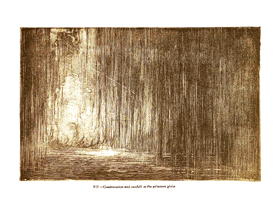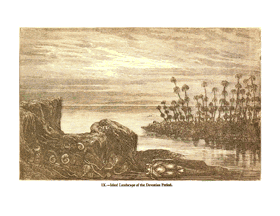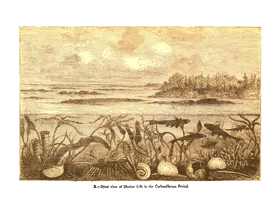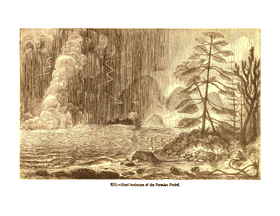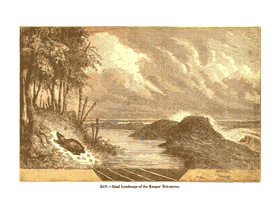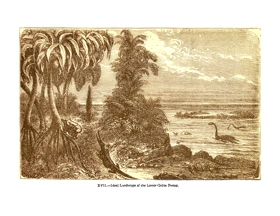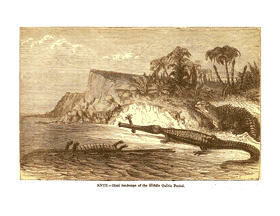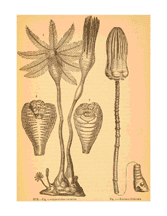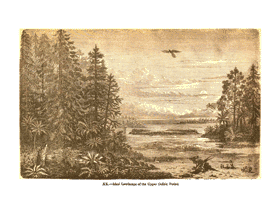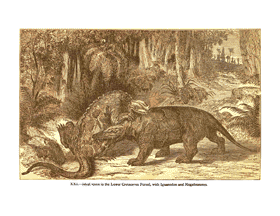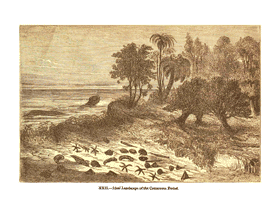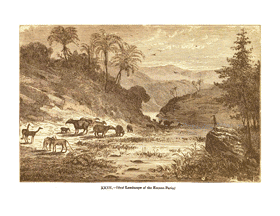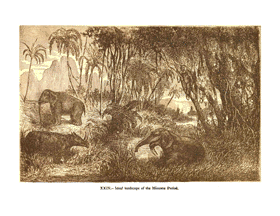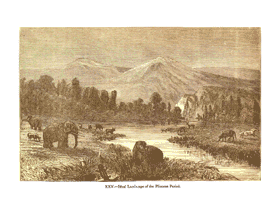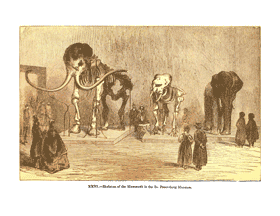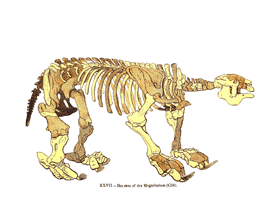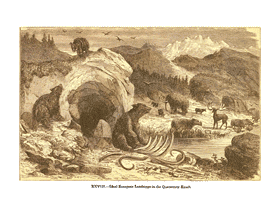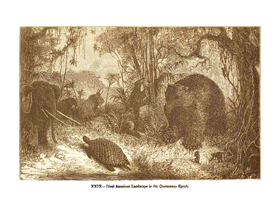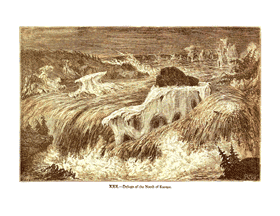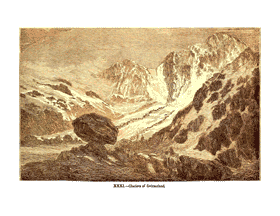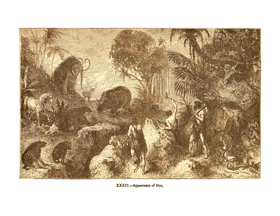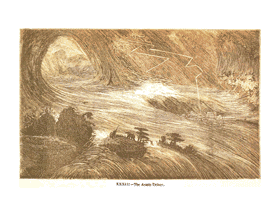PREFACE
iii
iv
v
GENERAL CONSIDERATIONS 1
001
002
003
CONSIDERATION OF FOSSILS 4
004
005
006
007
008
009
010
011
012
013
014
[009] For many years a vast assemblage of broken and contorted beds had
been observed on the borders of North Wales, stretching away to the
east as far as Worcestershire, and to the south into Gloucester, now
rising into mountains, now sinking into valleys. The ablest geologists
considered them as a mere labyrinth of ruins, whose order of succession
and distinctive organic remains were entirely unknown. "But came a
man," as M. Esquiros eloquently writes, "who threw light upon this
sublime confusion of the elements."
Sir Roderick Impey Murchison, then a
young President of the Geological Society, had his attention directed,
as he himself informs us, to some of these beds on the banks of the
Wye. After seven years of unremitting labour, he was rewarded by
success. He established the fact that these sedimentary rocks,
penetrated here and there by eruptive masses of igneous origin, formed
a unique system, to which he gave the name
Silurian, because the rocks which
he considered the most typical of the whole were most fully developed,
charged with peculiar organic remains, in the land of the ancient
Silures, who so bravely opposed the Roman invaders of their country.
[010] The success which attended Sir R. Murchison's investigations soon
attracted the attention of other geologists.
Professor Sedgwick examined the
older slaty strata, and succeeded in proving the position of the
Cambrian rocks to be at the base of the Silurian.
[010]
Hugh MIller and many
others had their attention occupied with the Old Red Sandstone -- the
Devonian -- which immediately overlies [the Silurian]. After a
youth passed in wandering among the woods and rocks of his native
Cromarty, the day came when Miller found himself twenty years of age,
and, for the time, a workman in a quarry. A hard fate he thought it at
the time, but to him it was the road to fame and success in life.
The quarry in which he laboured was at the bottom of a bay formed by
the mouth of a river opening to the south, a clear current of
water on one side, as he vividly described it, and a thick wood on the
other. In this silent spot, in the remote Highlands, a curious fossil
fish of the Old Red Sandstone was revealed to him; its appearance
struck him with astonishment; a fellow-workman named a spot where many
such monuments of a former world were scattered about; he visited the
place, and became a geologist and the historian of the "Old Red."
CHEMICAL AND NEBULAR HYPOTHESES OF THE GLOBE 15
015 016
017
018
019 020
021
022
023
024
025
[018] It is not to be supposed that amongst the various hypotheses of
which the cosmogony of the world has been the object, a literal
acceptation of the scriptural account finds no defenders among men of
science.
MODIFICATIONS OF THE EARTH'S SURFACE 26
026
027 028
029
ERUPTIVE ROCKS 30
030
PLUTONIC ERUPTIONS 31
031
032
033
034
035
036
037
038
Granite 31 Syenite 34
Protogine 35 Porphyry 37 Serpentine 38
VOLCANIC ROCKS 39
PRIMARY EPOCH 99
099
100
[099] During the primitive epoch the
temperature of the earth was too high to admit the appearance of life
on its surface. The darkness of thickest night shrouded this cradle of
the world; the atmosphere probably was so charged with vapours of
various kinds, that the sun's rays were powerless to pierce its
opacity. Upon this heated surface, and in this perpetual night, organic
life could not manifest itself. No plant, no animal, then, could exist
upon the silent earth. In the seas of this epoch, therefore, only
unfossiliferous strata were deposited.
Nevertheless, our planet continued to be subjected to a gradual
refrigeration on the one hand, and, on the other, continuous rains were
purifying its atmosphere. From this time, then, the sun's rays,
being less obscured, could reach its surface, and, under ther
beneficent influence, life was not slow in disclosing itself. "Without
light," said the illustrious Lavoisier, "Nature was without life; it
was dead and inanimate. A benevolent God, in bestowing light, has
spread on the surface of the earth organization, sentiment, and
thought." We begin, accordingly to see upon the earth -- the
terperature of which was nearly that of our equatorial zone -- a few
plants and a few animals make their appearance. These first generations
of life will be replaced by others of a higher organisation, until at
the last stage of creation, man, endowed with the supreme attribute
which we call intelligence, will appear upon the earth.
[100] During the earlier ages of our globe, the waters covered a great
part of its surface; and it is in them that we find the first
appearance of life. When the waters had become sufficiently cool
to allow the existence of organised beings, creation was developed, and
advanced with great energy; for it manifested itself by the appearance
of numerous and very different species of animals and plants.
CAMBRIAN PERIOD 101
101
SILURIAN PERIOD 102
102
103
104
105
106
107
108
109
110
111
112
113
114
115 116
117
118
[170] Sir Roderick Murchison defined
and named the Silurian System.
Lower Silurian Period 104
Upper Silurian Period 110
Carboniferous Limestone
140
140
141
142
143
144
145
146
147
148
149
150
151
152
153
154
155
Coal Measares 156
156
157
158
Formation of Coal 159
159
160
161
162
163
164
165
166
167
168 169
[161] If we bear in mind the remarkable
parallelism existing in the stratification of the coal-formation, and
the state of preservation in which the impressions of the most delicate
vegetable forms are discovered, it will, we think, be proved to
demonstration, that those coal-seams have been formed in perfect
tranquility. We are, then, forced to the conclusion that coal results
from the mineralisation of plants which has taken place on the spot;
that is to say, in the very place where the plants lived and died. ...
It has, also, been pointed out... that not only in this country, but in
the coal-fields of Nova Scotia, the United States, &c., every layer
of true coal is co-extensive with and invariably underlaid by a marked
stratum of arenaceous clay of greater or less thickness, which, from
its position relatively to the coal has been long known to coal-miners,
among other terms, by the name of
under-clay.
The clay-beds, "which vary in thickness from a few inches to more than
ten feet, are penetrated in all directions by a confused and tangled
collection of the roots and leaves, as they may be, of the
Stigmaria ficoides, these being
frequently traceable to the main stem (Sigillaria) ... From the
circumstance... it has been generally recognised as probably the truth
... that the
Stigmaria ficoides
is only the root of the
Sigillaria,
and not a distinct plant.
PERMIAN PERIOD 170
170
171
172
173 174
175
176
[170] The name "Permian" was proposed by Sir Roderick I. Murchison, in
the year 1841. ... The Permian rocks have assumed great interest,
particularly in England, in consequence of the evidence their correct
determination affords with regard to probable extent, beneath them, of
the coal-bearing strata which they overlie and conceal; thus tending to
throw a light upon the duration of our coal-fields.
Permian Rocks 177
177
178
179
180
181
182 183
184
|
SUMMARY OF THE PRIMARY EPOCH
[180] In this Primary period,
plants and animals appear for the first
time upon the surface of the cooling globe. The seas of the epoch were
then dominated by the fishes known as Ganoids
(from
the Greek ganos = glitter), from the brilliant polish of the
enamelled
scales which cover their bodies, cometimes in a very complicated and
fantastic manner; the Trilobites
are curious Crustaceans, which appear and altogether disappear in the
Primary epoch; an immense wuantity of Mollusca, Cephalopoda, and
Brachiopoda; the Encrinites,
animals of curious organisation, which form some of the most graceful
ornaments of our Palaeontological collections.
But, among all these beings, those which prevailed
-- those which
were truly the kings of the organic world -- were Fishes, and, above
all, the Ganoids, which have
left no animated being behind them of similar organization. Furnished
with a sort of defensive armour, they seem to have received from Nature
this means of protection to ensure their existence, and permit them to
triumph over all the influences which threatened them with destruction
in the seas of the ancient world.
In the Primary epoch ... no Mammals then roamed the
forests; no
bird had yet displayed its wings. ... On the land we only find a few
marsh-frequenting Reptiles, of small size. ... The vegetation is
chiefly of inferior organization. With a few plants of a higher order,
that is to say, dicotyledons, calamites, sigillarias, it was the
Cryptogamia (also several species of Ferns, the Lepidodendra ...) then
at their maximum of development, which formed the great mass of the
vegetation. ...
The same animals and the same plants then lived in
the
polar regions as at the equator.... we must conclude that the
temperature at this epoch was uniform all over the globe, and that the
heat of the earth itself was sufficiently high to render inappreciable
the calorific influence of the sun.
|
SECONDARY EPOCH 185
[185] During the
Primary Epoch
our globe would appear to have been chiefly appropriated to beings
which lived in the waters -- above all, to the Curstaceans and Fishes;
during the
Secondary Epoch
Reptiles seem to have been its prevailing inhabitants.
TRIASSIC, OR NEW RED PERIOD
185
185
186
New Red Sandstone 187
187
[187] In this hew phase ... the
Trilobites
have disappeared; the molluscous Cephalopods and Brachiopods are few in
number, as are the Ganoid and Placoid Fishes, whose existence also
seems to have terminated during this period, and vegetation has
undergone analogous changes. The cryptogamic plants become less
numerous, while the Conifers experienced a certain extension. For the
first time the Turtle appears. The Saurian reptiles acquire a great
development; they prepare the way for those enormous Saurians, which
appear in the following period.
Muschelkalk 188
188
189
190
191
192
193
194 195
196
197
198
Keuper Period 199
199
200
201
202
203
204
205
206
The footprints in Connecticut belong to this time, showing that birds
of great size have made their appearance.
RHAETIC (PENARTH) PERIOD 207
207
208
209
210
JURASSIC PERIOD 211
Liassic Period 211
211
212
213
214
215 216
217
218
219 220
221
222
223
224
225
226
227 228
229
230
231
232
233
234
235
236
237
238
239
240
241
242
[211] The Lias may be traced throughout a great part of Europe as a
separate and independent group, of considerable thickness, varying from
500 to 1,000 feet, containing many peculiar fossils, and having a very
uniform lithological aspect.
[214] The
Ammonites, a
curious genus of Cephalopoda, which made their first appearance in
small numbers towards the close of the Triassic period, become quite
special in the Secondary epoch, with the cloas of which they disappear
altogether. They were very abundant in the Jurassic period, and, as we
have already said, each zone is characerise by its peculiar
species. The name is taken from the resemblance of the shell to
the ram's-horn ornaments which decorated the front of the temple of
Jupiter Ammon.
[217] The seas of the period contained a great number of the fishes
called Ganoids; which are so-called from the splendour of the hard and
enamelled scales, which form a sort of defensive armour to protect
their bodies.
[218] The distinguishing features [of the Jurassic period] are found in
the enormous reptiles with lizard's head, crocodile's conical teeth,
the trunk and tail of a quadruped, whale-like paddles, and the
double-concave vertebrae of fishes; and this strange form on such a
gigantic scale that even their inanimate remains are examined with a
curiosity not unmixed with awe. The country around Lyme Regis, in
Dorsetshire, has long been celebrated for the curious fossils
discovered in its quarries.
[219] The quarries of Lyme Regis form the cemebery of the Ichthyosauri
[= fish-lizard] ... the dragons of the ancient seas.
In 1811 a country girl ... perceived some bones
projecting a little out of the cliff. Finding, on examination, that it
was part of a large skeleton, she cleared away the rubbish, and laid
bare the whole creature imbedded in the block of stone. She hired
workmen to dig out the block of Lias in which it was buried. In this
manner was the first of these monsters brought to light: "a monster
some thirty feet long, with jaws nearly a fathom in length, and huge
saucer-eyes; which have since been found so perfect, that the petrified
lenses have been split off and used as magnifiers."
The eyes of this marine monster were much larger
than those of any animal now living; in volume they frequently exceed
the human head, and their structure was one of their most remarkable
peculiarities. In front of the sclerotic coat or capsule of the eye
there is an annular series of thin bony plates, surrounding the
pupil. This structure, which is now only met with in the eyes of
certain turtles, tortises, and lizards, and in those of many birds,
could be used so as to increase or diminish the curvature of the
transparent cornea, and thus increase or diminish the magnifying power,
according to the requirements of the animal -- performing the office,
in short, of a telescope or microscope at pleasure. The eyes of the
Ichthyosaurus were, then, an optical apparatus of wonderful power and
of singular perfection.
[220] At no period in the earth's history have Reptiles occupied so
important place as they did in the Jurassic period. Nature seems to
have wished to bring this class of animals to the highest state of
development. The great Reptiles of the Lias are as complicated in their
structure as the Mammals which appeared at a later period.
[221] The great Saurians in the Lias of Lyme Regis seem to have
suffered a somewhat sudden death ... "In general the bones are not
scattered about, and in a detached state, as would happen if the dead
animal had descended to the bottom of the sea, to be decomposed, or
devoured piecemeal ...; on the contrary, the bones of the skeleton, ..
are tolerably connected, frrequently in perfect, or nearly perfect,
order, as if prepared by the anatomist. The skin, moreover, may
sometimes be traced, and the compressed contents of the intestines may
at times be also observed -- all tending to show that the animals were
suddenly destroyed, and as suddenly preserved." (De la Beche)
[230] The Plesiosaurus was first described by the Rev. W. D. Coybeare
and Sir Henry De la Becha, in the "Geological Society's Transactions"
for 182`. The first specimen was discovered in the Lias of Lyme Regis.
[233] There are no monsters in Nature; in no living creature are the
laws of organisation ever positively infringed; and it is more in
accordance with the general perfection of creation to se in an
organization so special, in a structure which differs so notably from
that of the animals of our own days, the simple development of a type,
and sometimes also the introduction of beings, and successive changes
in their structure. We shall see, in examining the surioud series
of animals of the ancient world, that the organization and
physiological functions go on improving unceasingly, and that each of
the extinct genera which preceded the appearance of man, present, for
each organ, modifications which always tend toward greater perfection.
The fins of the fishes of Devonian seas become the paddles of the
Ichthyosauri and of the Plesiosauri; these, in their turn, become the
membranous foot of the Pterodactyle, and, finally, the wing of the
bird. Afterwards comes the articulated fore-foot of the terrestrial
mammalia, which after attaining remarkable perfection in the hand of
the ape, becomes, finally, the arm and hand of man, an instrument of
wonderful delicacy and poser, belonging to an enlightened being gifted
with the divine attribute of reason! Let us, then dismiss any idea of
monstrosity with regard to these antediluvian animals; let us learn, on
the contrary, to recognise, with admiration, the divine proofs of
design which they display, and in their organization to see only the
handiwork of the Creator.
Oolitic Sub-Period 243
243
[243] This period is so named because many of the limestones entering
into the composition of the formations it comprises, consist almost
entirely of an aggregation of rounded concretionary grains resembling,
in outer appearance, the roe or eggs of fishes, and each of which
contains a nucleus of sand, around which concentric layers of
calcareous matter have accumulated. [ed. note: as if the "eggs"
precipitated out of a highly saturated mineral solution].
Lower Oolite Fauna
244
244
245
246
247
248
[244] The most salient and characteristic feature of this age is the
appearance of animals belonging to the class of Mammals. The first
mammals [were
Marsupial Mammals].
The Opossum, Kangaroo, and Ornithorhynchus are existing
represtentatives of this group.
[247] The Echinoderms and Polyps appear in great numbers in the
deposits of the Lower Oolite. ... [Coral] reffs were principally
constructed in the Jurassic period, and their extreme abundance is one
of the characteristics of this geological age.
[249] The Conifers began to occupy an important part in the world's
vegetation from this epoch.
Lower Oolite Rocks 249
249
250
251
252
253
254
Middle Oolite 255
255
256
257
258
259
260
261
262
263
264
Upper Oohte 265,
265
266
267
268 269
270
271
272
273 274
CRETACOUS PERIOD 275
275
276
277
278
279
280
281
282 283
284
285
[275] The name
Cretaceous
(from
creta, chalk) is given
to this epoch because the rocks deposited by the sea, towards its
close, are almost entirely composed of chalk (carbonate of lime).... If
chalk be examined with a microscope, it will be found to be composed of
the remains of numerous Zoophytes, of minute and divers kinds of
shells, and, above all, of Foraminifera.
TERTIARY EPOCH 312
312
313
314
[312] During the Primary period, Crustaceans and Fishes
predominated in the animal kingdom; in the Secondary period the earth
was assigned to Reptiles; but during the Tertiary period the Mammals
were kings of the earth.
If we except the Marsupials, the first created
Mammals would appear to have been the Pachyderms, to which the Elephant
belongs. This order of animals long held the first rank; it was almost
the only representative of the Mammal during the first of the three
periods of the Tertiary epoch.
We no loner find in the Tertiary seas those
Ammonites, Belemnites, and Hippurites which peopled the seas and
multiplied in such astonishing profusion during the Secondary period.
What occurs to us, however, as most remarkable in
the Tertiary epoch is the prodigious increase of animal life.
The Tertiary flora approaches, and is sometimes
nearly identical with, that of our days. The class of dicotyledons
shows itself there in its fullest development; it is the epoch of
flowers. Birds become more numerous. The atmosphere, purified and
disembarassed of the veil of vapour which has hitherto pervaded it, now
permits animals with such delicate pulmonary organs to live and
multiply their race. Climates would be developed in the various
latitudes; the temperature of the earth would still be nearly that of
our present tropics, and at this epoch, also, cold would begin to make
itself felt at the poles. ... We trace an alternate succession of beds
containing organic beings of marine origin, with others peculiar to
fresh water. It is at the end of this period that continents and seas
take their respective places as we now see them, and that the surface
of the earth received its present form.
Eocene Period 315
315 316
317
318
319 320
321
322
323
324
325
326
327 328
329
330
331
332
333
334
335
Miocene Period 336
336
337
338
339
340
341
342
343
344
345
346
347
348
349
350
351
352
353
354
355
356
[341] The
Mastadon was, to
all appearance, very nearly of the size and form of our Elephant -- his
body, however, being somewhat longer, while his limbs, on the contrary,
were a little thicker. He had tusks, and very probably a trunk, and is
chiefly distinguished from the existing Elephant by the form of
hismolar teeth, which form the most distinctive character in his
organization. ... [347] Cuvier [gave it] the name of Mastodon (from the
greek mastos = a teat and odous = a tooth), or teat-like-toothed
animal. The form of the teeth shows that it fed, like the Elephant, on
the roots and succulent parts of vegetables.
[349] The Apes made their appearance at this period.
Pliocene Period 357
357
358
359
360
361
362
363
364
365
366
367
368 369
370
371
372
373 374
375
376
377
[357] During the Pliocene period, many mountains and mountain-chains
were formed in Europe by basaltic and volcanic eruptions. Of genera
totally unknown till now, some of them, such as the Hippopotamus, the
Camel, the Horse, the Ox, and the Deer, survive to the present day.
[374] At the close of the Pliocene period, the continent of Europe was
nearly what it is now.... There is strong presumptive evidence that in
this period, or in that immediately subsequent to it, the entire
European area, with some trifling exceptions, including the Alps and
Apennines, emerged from the deep.
QUATERNARY EPOCH 378
The tranquillity of the globe was only disturbed during this era by
certain cataclysms whose sphere was limited and local, and by an
interval of cold of very extended duration; the
deluges and the
glacial
period.
POST-PLIOCENE 378
378
379
380
381
382 383
384
385
386
387
388
389
390
391
392
393
394 395
396
397
398
399
400
401
402
403
404
405
406
407
408
409
410
411
412
413
414
415 416
417
418
419 420
421
[381] It was the opinion of Cuvier and the early geologists that the
ancient species were destroyed in some great and sudden catastrophe,
from which none made their escape. But recent geologists trace their
extinction to slow, successive, and determinative action due to local
causes, the chief one being the gradual lowering of the temperature.
[391] In 1800, a Russian naturalist, Gabriel Sartyschew, travelled in
northern Siberia. Having arrived in the neighbourhood of the Frozen
Ocean, he found upon the banks of the Alasoeia, which discharges itself
into this sea, the entire body of a Mammoth enveloped in a mass of ice.
The body was in a complete state of preservation.
EUROPEAN DELUGES 422
422
423
424
425
426
427 428
429
430
431
432
433
434
GLACIAL PERIOD 435
435
436
437
438
439
440
441
442
443
444
445
446
447
448
449
450
451
452
453
454
455
456
457
458
459
460
461
462
463
CREATION OF MAN 464
464
465
466
467
468 469
470
471
472
473 474
475
476
477
478
479
[469] Volumes have been written upon the question of the unity of the
human race; that is, whether there were many centres of the creation of
man, or whether our race is derived solely from the Adam of Scripture.
We think, with many naturalists, that the stock of humanity is unique,
and that the different human races, the negroes, and the yellow race,
are only the result of the influence of climate upon organization.
ASIATIC DELUGE 480
480
481
482 483
484
485
486
487
488
[480] The Asiatic deluge -- of which sacred hstory has transmitted to
us the few particulars we know -- was the result of the upheaval of a
part of the long chain of mountains which are a prolongation of the
Caucasus. ... Volumes of watery vapour or steam accompnied the lava
discharged from the interior of the globe, which, being first
dissipated in clouds and afterwards condensing, descended in torrents
of rain, and the plains were drowned with the volcanic mud.
The particulars of the Biblical narrative [of the
Noahic
flood] are only to be explained by the volcanic and muddy
eruption which preceded the formation of mount Ararat. The waters which
produced the inundation of these countries proceeded from a volcanic
eruption accompanied by enormous volumes of vapour, which in due course
became condensed and descended on the earth, inundating the extensive
plains which now stretch away from the foot of Ararat.
[482] "All the earth" which might be implied to mean the entire globe,
is explained by Marcel de Serres... and other philologists, as being an
inaccurate translation. He has proved that the Hebrew word
haarrets, incorrectly translated
"all the earth," is often used in the sense of
region or
country, and that, in this
instance, Moses used it to express only the part of the globe which was
then peopled, and not its entire surface. In the same manner, "
the mountains" only implies all the
mountains known to Moses.
Nothing occurs, therefore, in the description given
by Moses, to hinder us from seeing in the Asiatic deluge a means made
use of by God to chastise and punish the human race, then in the
infancy of its existence, and which had strayed from the path which he
had marked out for it.
EPILOGUE 489
489
490
491
492
[489] Can the actual state of the earth
be considered as definitive? The revolutions which have fashioned its
surface, and produced the Alps in Europe, Mount Ararat in Asia, the
Cordilleras in the New World -- are they to be the last? ... It is
diffult to reply with any confidence to this question.
What are the causes which have produced the present inequalities of the
globe -- the mountain-ranges, continents, and waters? The primordial
cause is the cooling of the earth, and the progressive solidification
of the external crust, the nucleus of which still remains in a fluid or
viscous state. ... The secondary causes which have contributed to the
formation of a vast extent of dry land are due to the sedimentary
deposits, which have resulted in the creation of new continents by
filling up the basins of the ancient seas. Now these two causes,
although in a minor degree, continue in operation to the present day.
During the Metamorphic epoch the mineral
kingdom existed along; the rocks, silent and solitary, were all
that was yet formed of the burning earth. During the Primary epoch, the
vegetable kingdom, newly created, extended itself over the whold globe,
which it soon covered from pole to pole with an uninterrupted mass of
verdure. During the Secondary and Tertiary epochs, the vegetable
and animal kingdoms divided the earth between them. In the Quaternary
epoch the himan kingdom
appeared. Is it in the future destinies of our planet to receive
let another lord?
We must be content with suggesting, without hoping to solve, this
formidable problem. It is a great mystery, which, according to the fine
expression of Pliny, "lies hidden in the majesty of Nature;" or, (to
speak more in the spirit of Christian philosophy) it is known only to
the Almighty Creator of the Universe.
TABLE AND DIAGRAM OF BRITISH SEDIMENTARY AND FOSSILIFEROUS STRATA
INDEX
501
502
503
504
505
506
507
508
509
510
511
512
513
514
515 516
517
518
NOTE: High Resolution Images (400 ppi) of all figures are found here.
